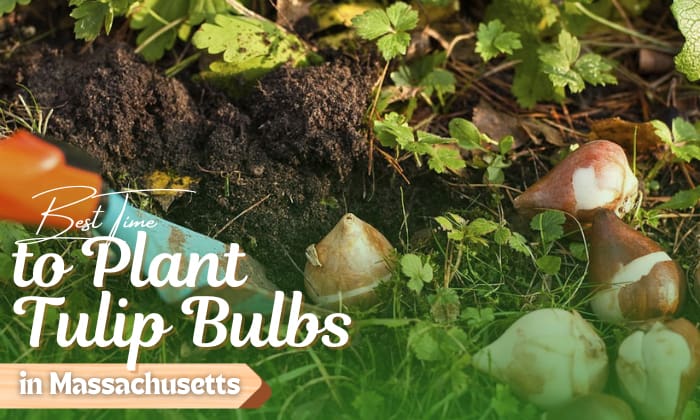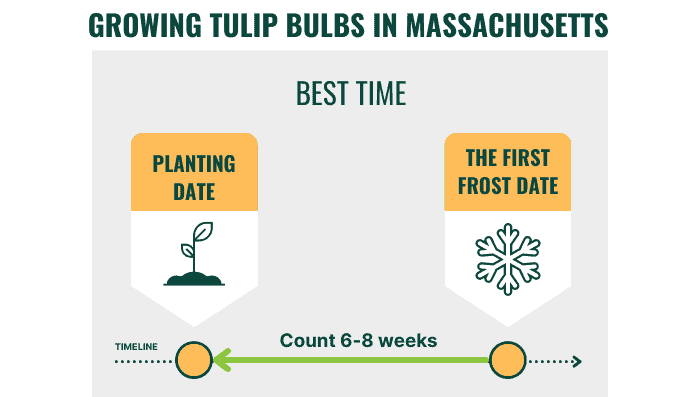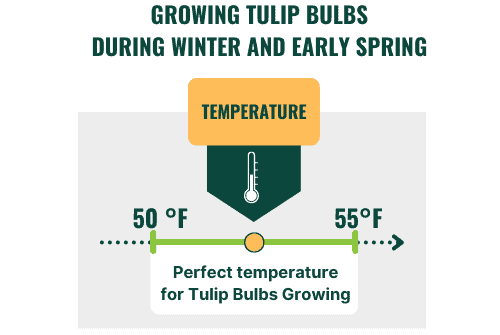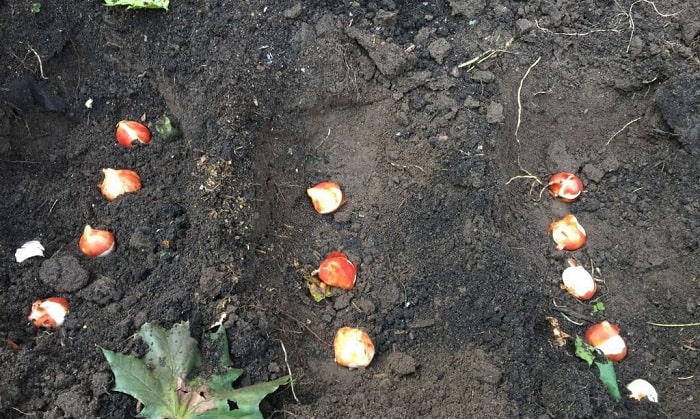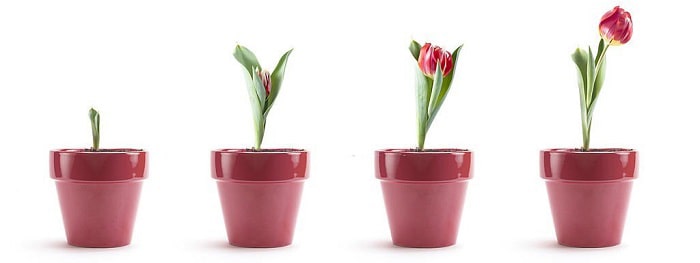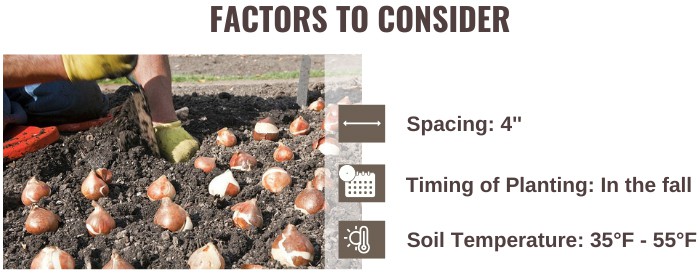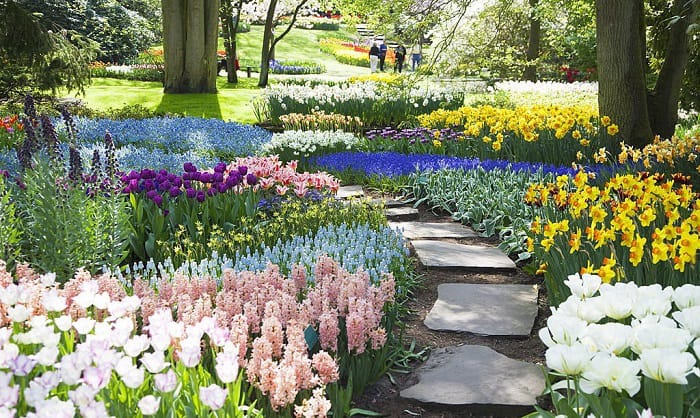Tulips have one of the most admired and brightly-colored blooms in the spring. To achieve bountiful blossoms, it is important to know when to plant their bulbs, especially in humid states like Massachusetts.
So, when to plant tulip bulbs in Massachusetts? Plant them before the first fall frost, from August 20 to October 20, depending on your location.
Read the planting guide below for more interesting and relevant information!
Table of Contents
Best Time to Plant Tulip Bulbs in Massachusetts
1. Planting before the first frost
Tulip bulbs suit a fall planting schedule in New England and other parts of Massachusetts. Planting bulbs in fall allows them a good time to establish themselves. Generally, they are grown 6 to 8 weeks before the first hard frost, which will differ from one location to another.
Refer to the table below for recommendations on planting tulip bulbs in Massachusetts based on its growing zones:
| Massachusetts Hardiness Zone | Plant Tulip Bulbs Before First Fall Frost |
| Zone 5 | August 20 to September 3 |
| Zone 6 | September 6 to 20 |
| Zone 7 | October 6 to 20 |
2. Planting during winter and early spring
Tulips are bulbs to plant in fall, but you might be wondering: when is it too late to plant tulip bulbs?
You can also grow tulips as spring bulbs, but because these plants require a chill period to bloom, it’s necessary to refrigerate them in late winter for ten to fourteen weeks under 39℉, then sow them outdoors in spring when the weather is 50 to 55 degrees.
In other words, you should pot your tulips in soil and keep them in the fridge for three months until the ground warms up in spring.
3. How late can you plant tulips?
In Massachusetts, you can generally sow them outdoors as late as mid-November while the ground is still workable.
How to Plant Tulip Bulbs Outdoors?
- Perform a soil test and make any necessary amendments.
- Remove and dispose of weeds prior to planting. Add a 2 to 3-inch layer of organic matter to improve drainage and compact soil structure.
- Using the bulb spacing chart below as reference for how deep to plant, prepare the planting hole by digging it twice the recommended depth. Fill the bottom half with organic matter before placing the tulip bulb inside.
- Afterwards, fill the rest of the hole with soil and thoroughly water the base of the plant, making sure it is sufficiently moist but not soaked through. Irrigate regularly with an inch of water per week.
How to Plant Tulip Bulbs Indoors?
- Choose a large container that is 15 inches in height and 18 inches in diameter. The bottom part of the pot should be broad enough that it doesn’t tip over when the tulips reach maturity.
- Fill the pot with well-draining soil, preferably sandy soil amended with organic matter.
- Plant the bulbs into the soil by letting the tips rest at the surface of the soil and the leaves facing outward on the flat part of the bulb. Space bulbs at most 2 inches apart.
- Place the pots somewhere that is cool, such as a basement refrigerator or unheated garage. Once the tulip bulbs finish chilling as described above, they will start growing sprouts.
- Water the soil regularly and move the bulbs to a sunny location they’ve been exposed to cold temperatures long enough.
Benefits of Growing Tulips
Tulips are inexpensive to grow and available in a variety of colors, such as red, purple, pink, and white. They complement other flowers like periwinkles and forget-me-nots and make for stunning bouquets, so if you want blooms in spring and early summer, tulips are a good choice to plant.
Factors to Consider When Planting Tulip Bulbs
1. Spacing
Adequate spacing promotes proper air circulation and reduces the risk of diseases, hence positively contributing to overall plant growth. You should space tulips four inches apart at the minimum.
2. Timing of Planting
One reason why fall is the best time for planting tulip bulbs is because cold temperatures will discourage fungal growth, making your bulbs more resilient against diseases. This schedule also supports the life stages of the bulb, as it allows tulips to grow roots before undergoing chilling.
3. Soil Temperature
Tulips prefer being planted in cool soil ranging from 35°F to 55°F. Anything above this range will adversely affect the plant’s blooms while colder temperatures can lead to injury.
Caring and Maintenance of Tulip Bulbs
- Fertilize either with a 10-10-10 or 4-12-12 granular fertilizer specially formulated for bulbs. When the plant starts blooming, switch to a liquid fertilizer.
- Inspect your plants for any possible fungi such as botrytis spores, which give an appearance of gray fuzzy tips on the tulip’s leaves, then deal with them as soon as possible by discarding the infected part of the plant or the entire plant itself.
- Remove the seed pods just before the flowers start producing seeds. However, do not cut the stems off but let them die naturally.
Frequently Asked Questions
Do tulip bulbs multiply?
Yes, certain species can, such as small early tulips. However, they would need one full year of maturity to begin naturally multiplying and spreading.
When do tulips bloom?
It depends on when you planted them as well as your location and weather conditions. Generally, they bloom in the spring from March to April and last about 1 to 2 weeks. Some varieties can begin blooming as late as June.
Can I plant bulbs now?
If it’s 6 to 8 weeks before the first fall frost in your area right now, then yes you can. Keep in mind that tulips are not bulbs to plant in summer for fall blooms.
How to prepare bulbs for planting?
There is no preparation needed if you’re planting tulips on time. However, you would need to soak them a full day before planting if you’re late.
Conclusion
Now that you definitely know how and when to plant tulip bulbs in Massachusetts, you can go off and grow a beautiful garden of colorful and wonderfully attractive tulips on your own in the comfort of your yard or lawn!
Just remember that timing, location, and temperature are important aspects to consider when planting your own tulip bulbs—and so are the plant’s location, sun, soil, and water requirements.
Related: Best time to plant tulip bulbs in Texas.

Hi, I am William – Floridayards’ digital content creator. My job is to find answers to all your concerns with thorough research and our team’s expert advice. I will also bring you honest reviews on the best products and equipment for raising your beautiful garden. Please look forward to our work!


